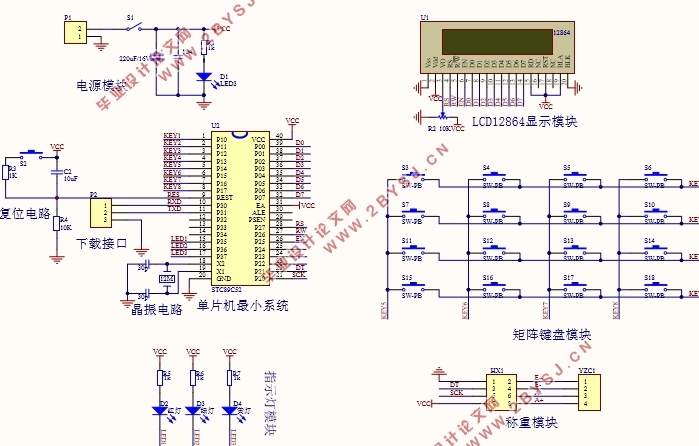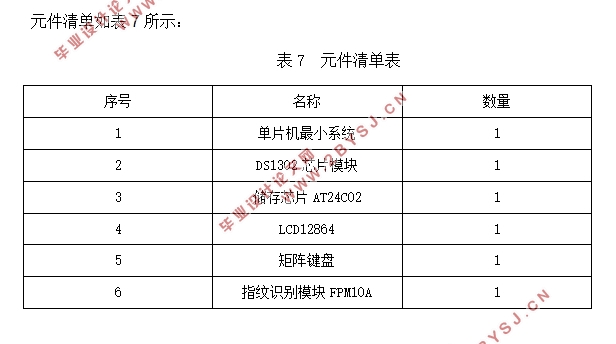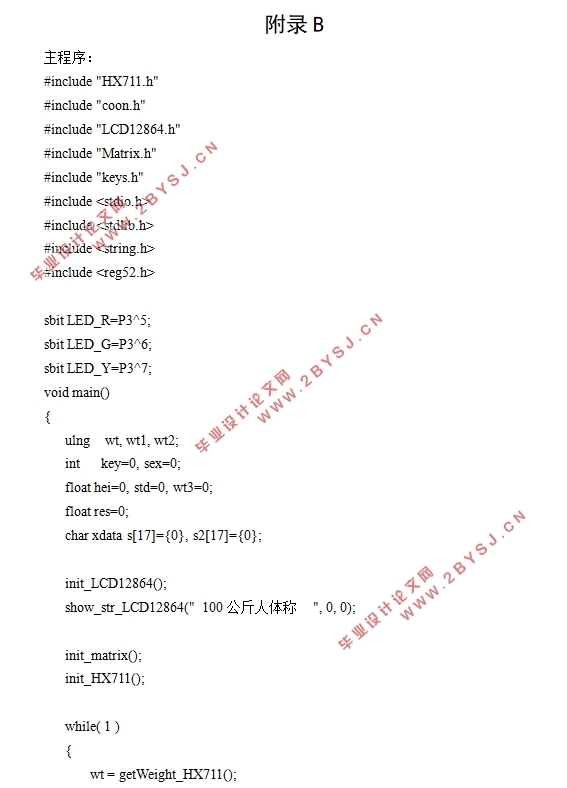基于单片机的人体体重测量仪设计(附程序代码,电路原理图)
无需注册登录,支付后按照提示操作即可获取该资料.
基于单片机的人体体重测量仪设计(附程序代码,电路原理图)(任务书,开题报告,外文翻译,论文17000字,程序代码,电路原理图)
摘要
本文介绍了基于单片机的人体体重仪设计,主要的传感部件是称重传感器。本设计中使用的是基于电阻应变片的平行梁称重传感器,它的特点是结构简单,测量精度高,其作用是将体重信息转变为电信号传送给单片机进行分析处理。同时在本设计中还有:液晶显示模块,用来显示体重等信息;矩阵键盘,用来进行性别选择和身高信息的输入;单片机处理模块,作为整个设计的核心,用来处理体重信息并与标准体重对比给出使用者体型的评估。
本设计通过称量得出人体体重,并通过矩阵键盘手动选择性别并输入身高,根据设定好的算法自动得出人体体型。结构清晰、电路简单、功能完备,满足设计要求。
关键词:STC89C52;LCD12864;HX711;矩阵键盘
ABSTRACT
This article describes the design of the human body weight scale based on MCU, The main sensor component is a load cell.The Parallel Beam Load Cells has been used in this design is based on the use of resistance strain gauge,It characterized by simple structure, high accuracy,Its role is to weight the information into electrical signals transmitted to the microcontroller for analysis and processing.In this design, Also has:LCD module,Used to display information such as weight;Matrix keyboard,Used for sex selection and input height information;MCU processing module,As the core of the design,To handle your weight and Comparison with the standard weight is given to assess the user's body.
This design results of body weight by weighing,And sex selection through the keyboard and manually enter the height,Auto derives body types according to predetermined algorithm.It has a clear structure,Simple circuit,Fully functional,Meet the design requirements.
Key words:STC89C52;LCD12864;HX711;Matrix Keyboard




目录
第1章 绪论..................................................................1
1.1 人体体重测量仪国内外的发展现状.........................................1
1.2 称重传感器发展过程.....................................................1
1.3 设计概述...............................................................2
第2章 方案设计..............................................................4
2.1 总体方案设计...........................................................4
2.1.1 设计方案确定.......................................................4
2.1.2 人体体重测量仪工作过程.............................................5
2.2 称重模块的设计.........................................................6
2.2.1 方案筛选...........................................................6
2.2.2 方案确定...........................................................8
2.3 HX711AD转换模块........................................................8
2.4 性别身高输入模块的设计.................................................9
2.5 液晶显示模块的设计....................................................10
2.5.1 方案筛选..........................................................10
2.5.2 方案确定..........................................................11
第3章 硬件电路设计.........................................................12
3.1 电源的电路设计........................................................12
3.2 单片机最小系统的电路设计..............................................12
3.3 液晶显示的电路设计....................................................15
3.4 键盘的电路设计........................................................15
3.5 称重模块的电路设计....................................................16
3.6 指示灯的电路设计......................................................17
3.7 硬件电路总体功能......................................................18
第4章 软件程序设计.........................................................19
4.1 系统主程序............................................................19
4.2 延时程序..............................................................20
4.3 LCD12864程序..........................................................21
4.4 矩阵键盘程序..........................................................22
4.5 HX711程序.............................................................25
第5章 设计总体测试.........................................................28
第6章 经济性分析...........................................................32
第7章 总结.................................................................33
参考文献...................................................................34
致谢......................................................................35
附录A......................................................................36
附录B......................................................................37
